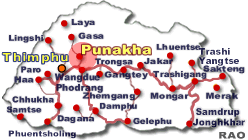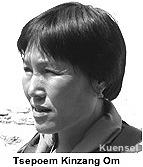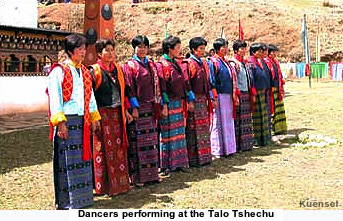 |
Bhutan's
Festivals |
|
 |
Bhutan Information |
|
|
 |
|
Mani
sum: the sacred songs of Talo Tshechu
|
It
is a chilly morning but 64-year old Rinchen Dema is perspiring and panting.
She has been walking for an hour carrying a bulky lunch pack from her village,
Botokha, nearby Talo.
 |
| It
is the second day of the Tshechu in Talo - the seat of the mind
incarnations of the Zhabdrung.
Rinchen
Dema settles in a corner and waits for her favorite programme - the Zhungdra
(classical song sung in meditative style without music) performance
by the Talo dance troupe. |
|
|
Talo
Tshechu |

|
 |
| "Very
soon my legs will not be able to carry me to this ground," says Rinchen
Dema, once a member of the Talo dance troupe for 16 years, as she prepares
to spend the day in Talo.
The
three-day Talo Tshechu is well known for its mask and Atsara dances,
but an equally popular attraction with deep religious and historical significance
is the Zhungdra by the Talo dance troupe. |
|
"The Zhungdra
performance particularly three songs known as Mani Sum are very close
to the heart of the Talops," says Bhutanese traditional dance master,
73 year-old Ap Dawpel.
Probably
the only dance master alive to retell the importance of the Talo Zhungdras,
Ap Dawpel says that the Mani Sum was composed by Meme Sonam Dhondup,
the grandfather of Zhabdrung Jigme Chogyal
(1862-1904), the fifth mind reincarnation
of the first Zhabdrung (1594-1651).
The
three songs of Mani Sum are performed at the closing item on each
day of the three-day Tshechu. Samyi Sala is performed on the first day,
followed by Drukpai Dungye on the second day and Thowachi Gangi
Tselay on the third and last day.
According
to Ap Dawpel, Zhabdrung Ngawang Choegyal in his last words (Sung
Chem) requested his younger brother Mepham Kuenga Dra to perform
the mask dances and the songs composed by his grandfather every
year during the Talo Tshechu. Samyi Sala was composed when
the Talo Sanga Choeling Dzong was built. "The inspiration to build the
Talo Dzong was drawn from the Samyi monastery in Tibet. Talo was
then compared to the Samyi monastery," Ap Dawpel says. Drukpai Dungye tells
the story of the Zhabdrung lineage, and Thowachi Gangi Tselay is
the thanksgiving or the Tashi Deleg song.
Another
notable Talop song is the Drongla ya ya, which was composed by Zhabdrung
Jigme Choegyal's father, Kencho Wangdi. The song praises in detail
the Talo monastery from the cobblestone flooring in the courtyard to the
ladders that reach to the seat of the Zhabdrung.
The
songs have passed down from generation to generation without the slightest
change in tune and lyrics, according to Ap Dawpel. "It is close to the
heart of the Talops because it is like a priceless inheritance and has
been blessed by many great Lamas," he adds. The songs, hand written on
ancient scrolls, are registered as a property of the Talo monastery.
"Very
soon my legs will not be able to carry me to this ground," says Rinchen
Dema, once a member of the Talo dance troupe for 16 years, as she prepares
to spend the day in Talo.
The
three-day Talo Tshechu is well known for its mask and Atsara dances,
but an equally popular attraction with deep religious and historical significance
is the Zhungdra by the Talo dance troupe. According to Ap
Dawpel, Meme Sonam Dhondup first taught the Mani Sum to his
two younger sisters, Aum Kaka and Tshering Lham. Ap dopey recalls his parents
telling him that the two sisters took about two weeks to master the songs
and the steps of the accompanying dance. "The steps might appear simple,
but it takes months to perfect the movement," says Ap Dawpel.
 |
| Tsepoem
(dance leader) Kinzang Om agrees. The 40-year old dance leader who
started dancing at the age of 17 says that one perform the Mani Sum in
two weeks but without the subtle nuances. "I have been singing and dancing
for the last 23 years and I still need to practice the Mani Sum," she says.
One
unique feature of the Talo Zhungdras is that only the Talops are allowed to learn the songs. "The songs are blessed and people from
other places other than Talo will find it difficult," Ap Dawpel says. "If
not performed properly it can bring misfortune in the form of natural calamities
and outbreak of diseases." |
|
According
to a village elder the women of the dance troupe must refrain from sexual
intercourse three days before the Tshechu to maintain the sanctity of the
Tshechu. Others say that learning, dancing, and singing these songs has
become an obligation for the Talops who are one way or the other linked
with the various incarnations of the Zhabdrungs.
According
to Kinzang Om, she gets a spiritual satisfaction from being part of the
age-old tradition. "It is a big responsibility for the Talops and we enjoy
shouldering our responsibility," she says. Another dancer feels that learning
and performing the Mani Sum was a way to honour ancestors and keep alive
an important tradition.
The
troupe starts practicing 16 days before the Tshechu with a daily allowance
of Nu. 30. According to Tsepoem Kinzang Dem, new comers in the troupe cannot
untie a single knot of the song in 16 days. "I have tried to teach some
dancers from other places and they find it very difficult. I think these
songs are meant only for Talops." "The Talops are known for their
excellence in the Zhungdra," says Aum Ugyen Dem, a villager from
Lobesa, "They are known for their rhythm, voice and the steps." While the
Talops take pride in their rich tradition, veterans like Ap Dopey and Kinzang
Om are worried by the growing influence of modern Bhutanese music.
Even
the Talo Tshechu is changing according to Ap Dawpel. The songs are
now performed outside the dzong and the number of dancers has increased
to 11 from seven, Boedra (lively folk songs originally performed by
Boegarps or court attendants) has been introduced, and people crave
for Rigsar (modern Bhutanese songs) during the Tshechu.
The
veteran has another concern. "There will be no one to retell the story
of the songs," he says. "Rigsar, which is more appealing to the youth will
take over and these songs will only be a history."
On
his part Ap Dopey attends the Talo Tshechu every year and personally coaches
the troupe and monitors the mask dance practice before the Tshechu.
 |
| Kinzang
Om fears that one day there will be no dancers during the Talo Tshechu.
"All the girls are now going to school and show little interest in these
kind of songs," she says. "The government should intervene to help this
tradition alive for ever."
According
to the principal of the Royal Academy
for Performing Arts (RAPA), no research has been done because these
songs were registered under the Thram of the Talo monastery. |
|
The RAPA dancers
do not know how to perform these songs. "We made research attempts, but
we were told that these songs were not for public entertainment," Principal
Thinley Jamtsho said.
"These
songs are performed only during the Talo Tshechu and if RAPA performs
it everywhere, the blessings would be lost," he added.
However,
a Bhutanese ethnomusicologist, Jigme Drukpa of the academy has been following
Ap Dopey to the Tshechu to study the songs and dances.
Back
in the corner of Talo dzong, Rinchen Dema is least bothered by the afternoon
wind. She hums along with the troupe as she prepares to leave satisfied.
"I prayed to come back safely next year," she says as she tries to recollect
a few lines from her favourite number, Drongla ya ya.
 |
| Contributed
by Ugyen Penjor, Kuensel |
 |
2005
| Talo
is in Punakha valley and it used to be closed to visitors. Some of the
Travel Agents had promoted Talo Tshechu and they had problems since they
were not allowed to take guests to the festival. |
|
| Information on Bhutan |
 |
|







